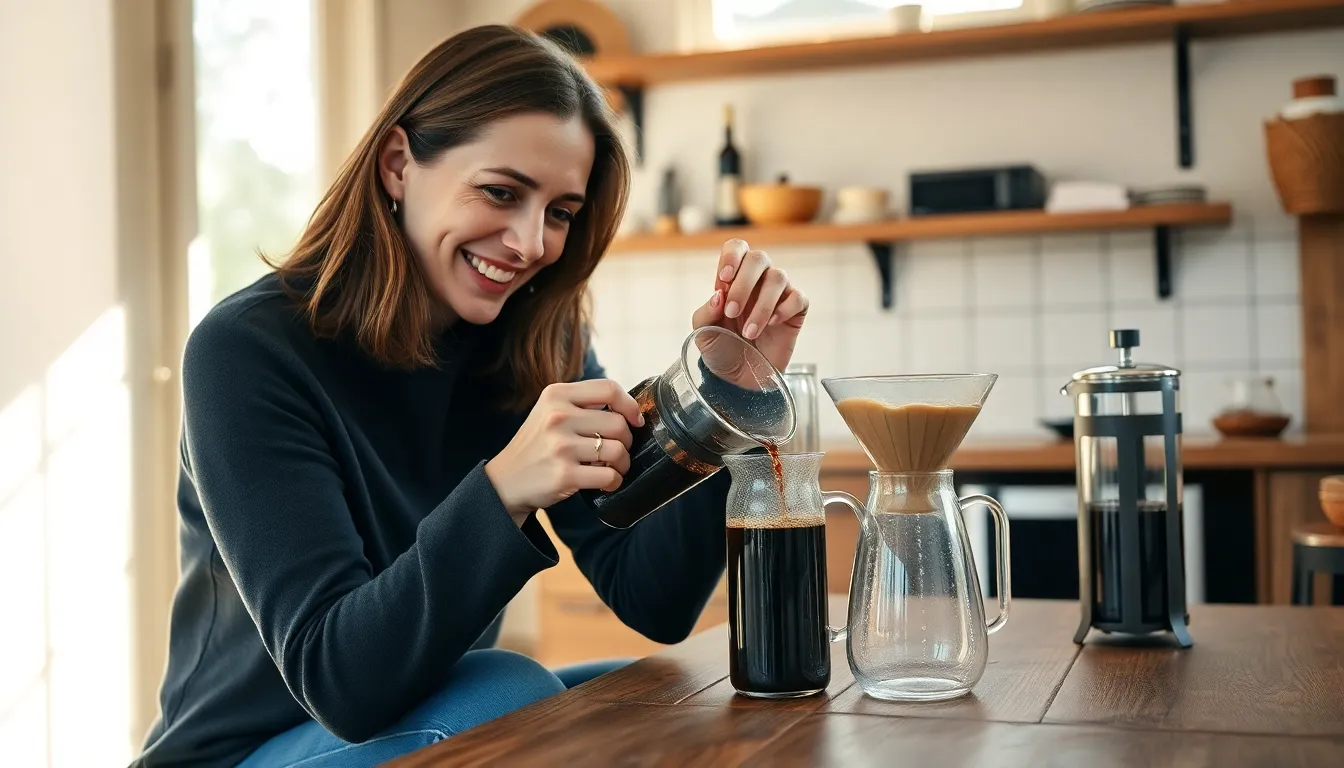Ever wondered how a French Press and Chemex actually differ when it comes to brewing your morning coffee? These two popular brewing methods deliver distinctly different cups even though their simple appearances.
The French Press offers a full-bodied, rich coffee experience through its immersion brewing technique, while the Chemex creates a cleaner, brighter cup with its specialized filters and pour-over design. Your preference between these two methods might depend on whether you favor bold, robust flavors or a more delicate, nuanced brew. Both have devoted followers and understanding their differences can help you discover your perfect coffee companion.
French Press vs Chemex: An Overview of Two Classic Coffee Brewing Methods
The French Press and Chemex represent two distinct approaches to coffee brewing, each with loyal followings among coffee enthusiasts. French Press utilizes an immersion brewing method where coffee grounds steep directly in hot water, creating a full-bodied cup with rich oils and sediment. Chemex, on the other hand, employs a pour-over technique with specialized filters that remove oils and fine particles, resulting in a clean, bright flavor profile.
Origins of these brewing methods reveal their enduring appeal. The French Press dates back to the 1920s with its straightforward plunger design, while the Chemex emerged in 1941 as both a brewing device and an art piece worthy of museum display. Both have stood the test of time for good reason—they deliver exceptional coffee when used correctly.
Design differences between these brewers are immediately apparent. The French Press features a cylindrical glass or metal carafe with a plunger and mesh filter, presenting a rustic, functional aesthetic. Chemex showcases an hourglass-shaped vessel with a wooden collar and proprietary paper filters, embodying mid-century modern design principles that balance form and function.
Brewing mechanics highlight fundamental differences in extraction philosophy. French Press keeps grounds and water in constant contact throughout the brewing process, extracting more compounds from the coffee. Chemex’s controlled pour-over method allows gravity to pull water through the grounds at a measured pace, giving you precise control over extraction variables.
The French Press: Design and Brewing Mechanism
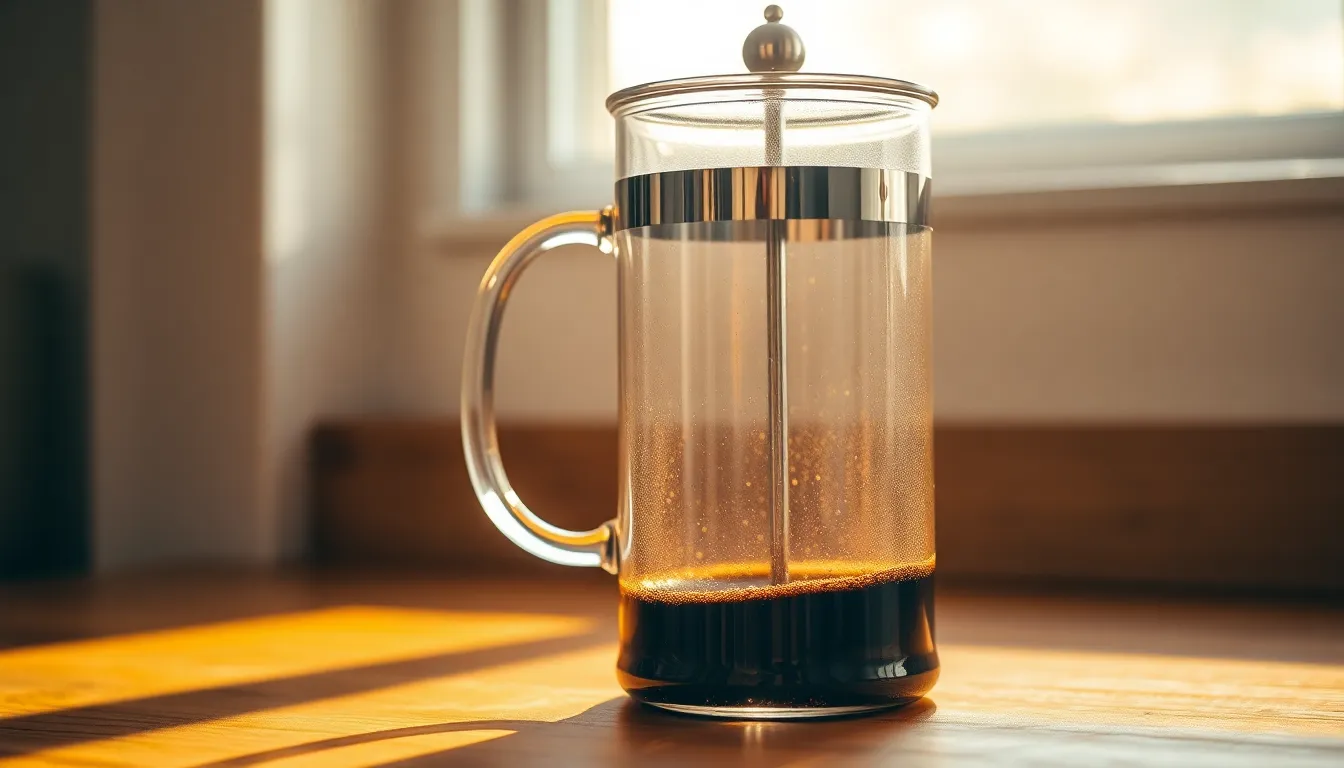
The French Press stands as one of the most accessible yet effective coffee brewing methods available today. Its straightforward design and immersion brewing process create a distinctively rich cup that many coffee enthusiasts cherish for its full-bodied character.
Materials and Construction
French Press brewers typically feature a cylindrical vessel crafted from durable materials that withstand heat and repeated use. Glass carafes offer visibility during the brewing process, allowing you to monitor extraction. Stainless steel models provide exceptional durability and heat retention, making them ideal for travel or outdoor use. Some manufacturers also produce plastic versions that resist breaking and maintain affordability. The defining component is the plunger assembly with its fine metal mesh filter, designed to separate grounds from liquid while allowing essential oils to pass through for a fuller flavor profile.
How the French Press Works
The French Press employs an immersion brewing method where coffee grounds remain in direct contact with water throughout the extraction process. You’ll start by adding coarse coffee grounds to the empty carafe, then pouring hot water (195-205°F) directly over them. The grounds and water steep together for 4-5 minutes, facilitating complete flavor extraction as oils and compounds dissolve into the water. Once brewing completes, pressing the plunger downward separates the grounds from your finished coffee. This technique preserves coffee’s natural oils and fine particles in your cup, creating a rich, aromatic brew with substantial mouthfeel. French Press coffee displays remarkable depth of flavor but typically contains some sediment at the bottom of your cup. The method particularly enhances darker roasts and coffees with chocolate or nutty flavor profiles from regions like Colombia or Indonesia, amplifying their inherent richness and body.
The Chemex: Design and Brewing Mechanism

The Chemex combines artistic design with precise brewing science to create a distinctly clean cup of coffee. Its elegant form serves both aesthetic and functional purposes, setting it apart from other brewing methods.
Materials and Construction
Chemex brewers feature a stunning hourglass-shaped carafe crafted from borosilicate glass, known for excellent heat retention and durability. This iconic design has earned recognition beyond the coffee industry, securing a place in the Museum of Modern Art for its artistic merit. The brewer’s signature thick paper filters are 20-30% heavier than standard coffee filters, creating a crucial difference in the brewing process. These specialized filters effectively remove fine particles and oils from your coffee, resulting in exceptional clarity in the final cup. Many coffee enthusiasts appreciate the wooden collar with leather tie that adorns the middle of the carafe, providing both insulation for handling and a distinctive visual accent.
How the Chemex Works
Brewing with a Chemex involves a methodical pour-over technique that maximizes flavor extraction. You’ll start by placing medium-coarse ground coffee into the thick paper filter positioned in the wide upper chamber of the carafe. The brewing process begins with adding a small amount of hot water to the grounds, allowing them to “bloom” for 30-45 seconds—this releases trapped gases and enhances flavor development. After blooming, continue pouring hot water slowly in a controlled circular motion over the grounds. Gravity pulls the water through the coffee bed and thick filter, creating a clean extraction that highlights bright acidity and nuanced flavor notes. The Chemex particularly excels at showcasing the fruity and floral characteristics in light to medium roasted single-origin coffees. The entire brewing process typically takes 3-4 minutes, with the thick filter providing resistance that slows extraction to the ideal rate for flavor development.
Taste Comparison: Coffee Flavor Profiles
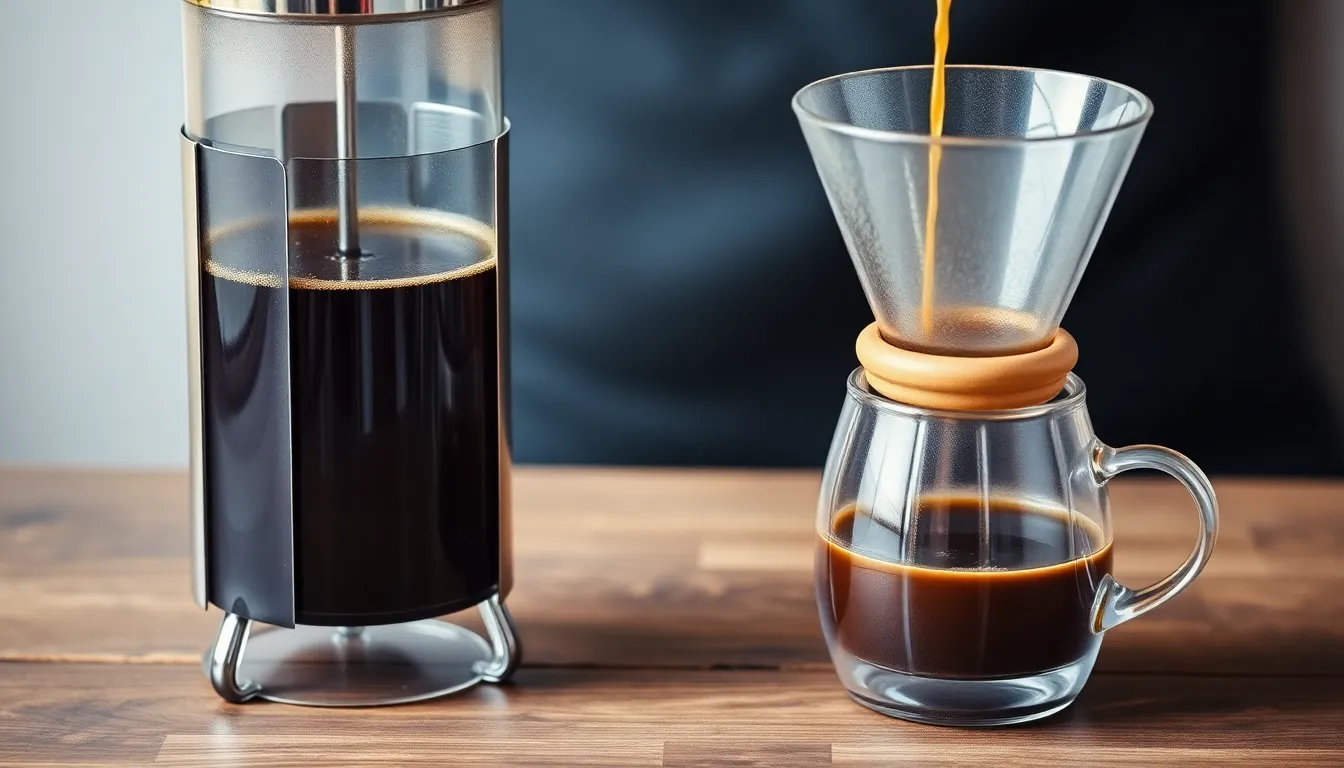
The French press and Chemex brewing methods create distinctly different flavor experiences due to their unique extraction processes and filtration systems. These differences manifest in body, acidity, and overall taste profile that can dramatically change how you experience your morning cup.
French Press Flavor Characteristics
French press coffee delivers a bold, robust flavor profile thanks to its immersion brewing method where grounds steep directly in hot water. Coffee oils remain intact throughout the brewing process since the metal mesh filter only separates the grounds without absorbing oils. This retention of natural compounds creates a full-bodied cup with a thick, almost syrupy mouthfeel that coats your palate. Many coffee enthusiasts appreciate the French press’s ability to produce a less acidic brew with a perfect level of bitterness, making it ideal for showcasing Indonesian or Colombian varieties. Dark roasts particularly shine in a French press, with their chocolate and nutty notes becoming more pronounced and complex. The trade-off comes in the form of some sediment that may appear at the bottom of your cup, a small price to pay for such a rich coffee experience.
Chemex Flavor Characteristics
Chemex brewing yields a remarkably clean, bright cup of coffee with pronounced clarity and nuance. The specialized thick paper filters remove most oils and fine particles, resulting in a lighter-bodied coffee that emphasizes the subtle flavor notes often masked in other brewing methods. Fruity and acidic characteristics become more distinguishable, allowing the complexity of Ethiopian, Kenyan, or Guatemalan coffees to take center stage. The crisp mouthfeel offers a different sensory experience compared to the French press, with each sip presenting distinct flavor transitions rather than uniform richness. Light to medium roasts excel in the Chemex system, revealing floral, citrus, and berry notes with exceptional precision. The brewing process takes approximately 3-4 minutes and consistently delivers a sediment-free cup that showcases the coffee’s natural brightness and delicate flavor profile.
| Feature | French Press | Chemex |
|---|---|---|
| Brewing Method | Immersion with metal mesh filter | Pour-over with thick paper filter |
| Body | Thick, full-bodied, rich | Light, clean, bright |
| Flavor Notes | Bold, robust, less acidic | Bright, nuanced, fruity, more acidic |
| Mouthfeel | Thick, heavy | Crisp, clear |
| Sediment | Some present | Virtually none |
| Ideal Coffee Types | Indonesian, Colombian, dark roasts | Ethiopian, Kenyan, light/medium roasts |
| Brewing Time | 4-5 minutes | 3-4 minutes |
Brewing Process Comparison
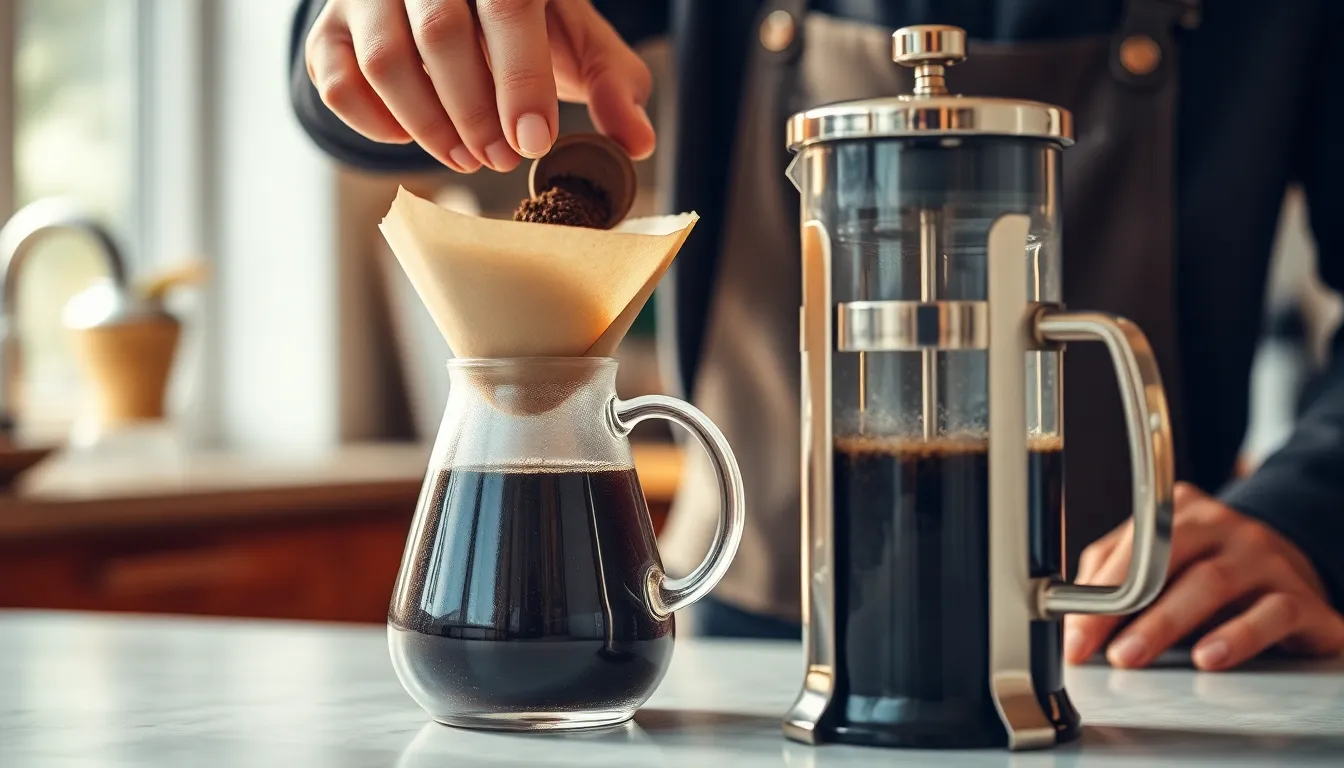
The French Press and Chemex represent two distinct approaches to coffee extraction, each yielding unique flavor profiles through fundamentally different brewing mechanics. These methods differ significantly in their extraction techniques, equipment requirements, and the resulting cup characteristics.
French Press Brewing
French Press brewing employs an immersion technique where coarse coffee grounds steep directly in hot water for approximately 4 minutes. After steeping, a metal mesh plunger separates the grounds from the liquid by pressing them to the bottom of the carafe. This method preserves the coffee’s natural oils and allows fine particles to remain in the final brew, creating a rich, full-bodied coffee with noticeable sediment. The direct contact between water and grounds throughout the brewing process extracts a wide range of flavor compounds and aromatic elements.
Chemex Brewing
Chemex brewing follows a pour-over methodology using a specialized thick paper filter. Medium-coarse grounds rest in the filter while near-boiling water is poured over them in a controlled manner. The brewing process relies on gravity as water passes through the coffee bed and filter, typically taking 4-5 minutes to complete. Chemex filters are significantly thicker than standard paper filters, effectively removing oils and sediment to produce an exceptionally clean, bright cup with enhanced clarity and reduced body compared to French Press coffee.
Brew Time and Effort
Both brewing methods require approximately 4-5 minutes of total brewing time, making them comparable in time commitment. French Press brewing demands minimal active attention during the steeping phase but requires precise timing to avoid over-extraction. Chemex brewing necessitates more continuous involvement through controlled pouring techniques, with attention to water flow rate and even saturation of the coffee bed. The pour-over technique for Chemex involves creating a “bloom” phase by initially wetting the grounds and allowing carbon dioxide to escape before completing the brewing process with carefully timed water additions.
Grind Size Requirements
French Press brewing requires a consistently coarse grind profile to function properly. Coarse grounds prevent small particles from passing through the mesh filter and reduce the likelihood of over-extraction leading to bitterness. Coffee ground too finely for French Press can create excessive resistance during plunging and result in muddy, over-extracted coffee with harsh flavors.
Chemex brewing works best with medium-coarse grounds that balance extraction rate with flow speed. Grind size directly impacts how quickly water moves through the coffee bed – too fine a grind restricts water flow and extends brewing time, potentially causing over-extraction and bitterness. Conversely, overly coarse grounds allow water to pass too quickly, resulting in under-extraction with sour, acidic notes dominating. Consistent grind particle size distribution remains crucial for achieving balanced extraction in both methods.
Practical Considerations
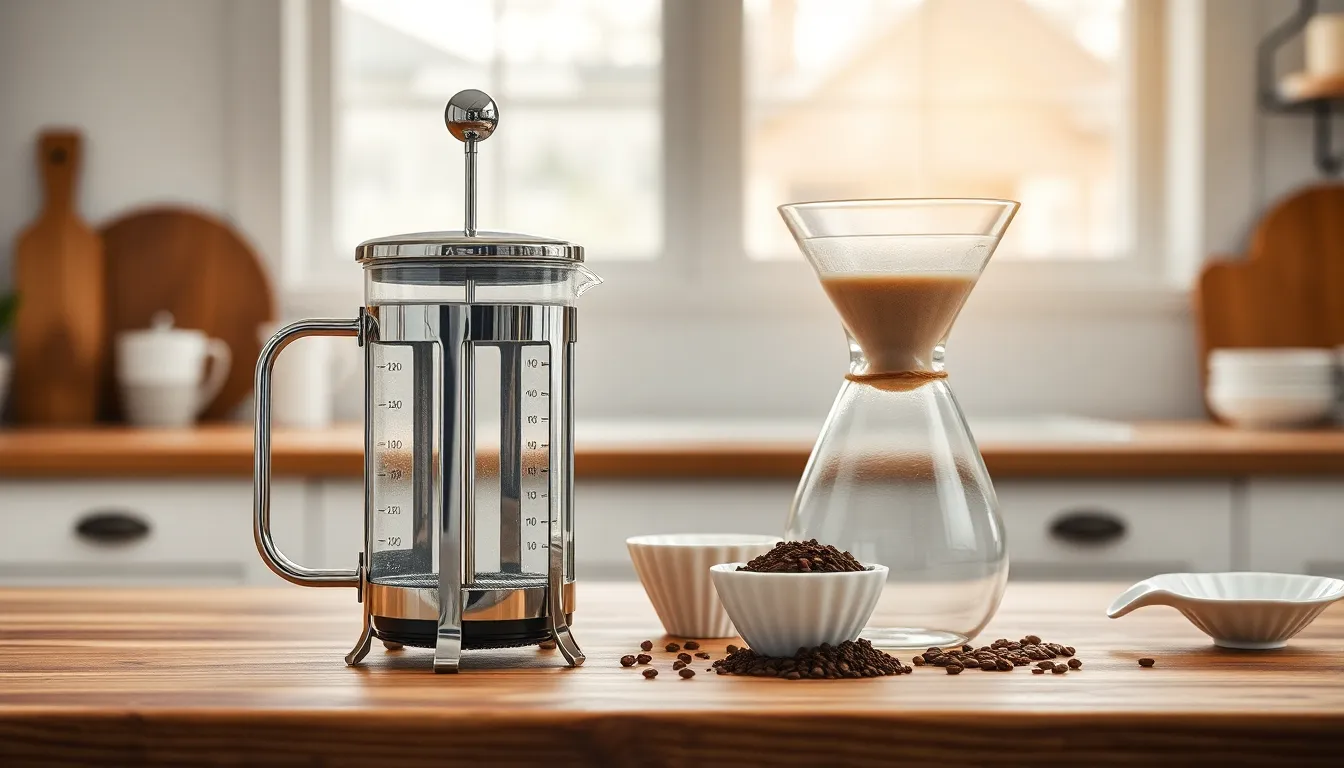
When choosing between a French Press and Chemex, practical factors often influence your decision as much as flavor preferences. These considerations include investment cost, cleaning requirements, and overall durability—all of which impact your daily coffee routine and long-term satisfaction with your brewing method.
Price Points and Investment
French Press brewers represent a more budget-friendly option for coffee enthusiasts, typically ranging from $20 to $40 depending on size and materials. These accessible price points make French Presses an excellent entry point for anyone beginning their specialty coffee journey. Multiple manufacturers offer French Presses in various materials including metal, glass, and plastic, with travel-friendly versions available for coffee on the go.
Chemex brewers command a higher price point, with standard models starting around $45 and premium versions exceeding $60. This higher investment reflects the Chemex’s status as both a brewing device and design piece. The limited manufacturing—primarily by one company—contributes to this premium positioning, especially for hand-blown glass versions that further elevate the price tag.
Cleaning and Maintenance
French Press cleaning presents one of its few drawbacks, requiring a somewhat laborious process to remove used grounds. The mesh filter and plunger assembly need regular attention to prevent buildup that can affect flavor. Disposing of grounds proves particularly challenging without a garbage disposal, as coffee sediment can potentially clog drains when rinsed down the sink. Many users develop a routine of scooping out grounds before rinsing to minimize mess.
Chemex maintenance offers important convenience through its disposable filter system. After brewing, you simply lift out the paper filter containing all grounds and discard it in one clean motion. The glass carafe itself needs regular washing, though its narrow neck requires a specialized bottle brush for thorough cleaning of hard-to-reach areas. This straightforward cleaning process saves valuable time during busy mornings.
Durability and Longevity
French Press durability varies significantly based on construction materials. Metal and plastic models tend to withstand daily use and occasional accidents better than their glass counterparts. The mesh filter component may eventually wear out with regular use, but manufacturers typically offer replacement parts that extend the brewer’s lifespan considerably. This repairability makes French Presses a lasting investment for many coffee drinkers.
Chemex brewers require careful handling due to their all-glass construction. The single-piece design means any important impact could render the entire brewer unusable. But, this simplicity also means fewer mechanical parts to fail over time. With proper care, a Chemex can serve as a reliable brewing companion for years, though its fragility demands mindful placement away from counter edges and sink areas where accidents commonly occur.
Which Method Is Right for You?
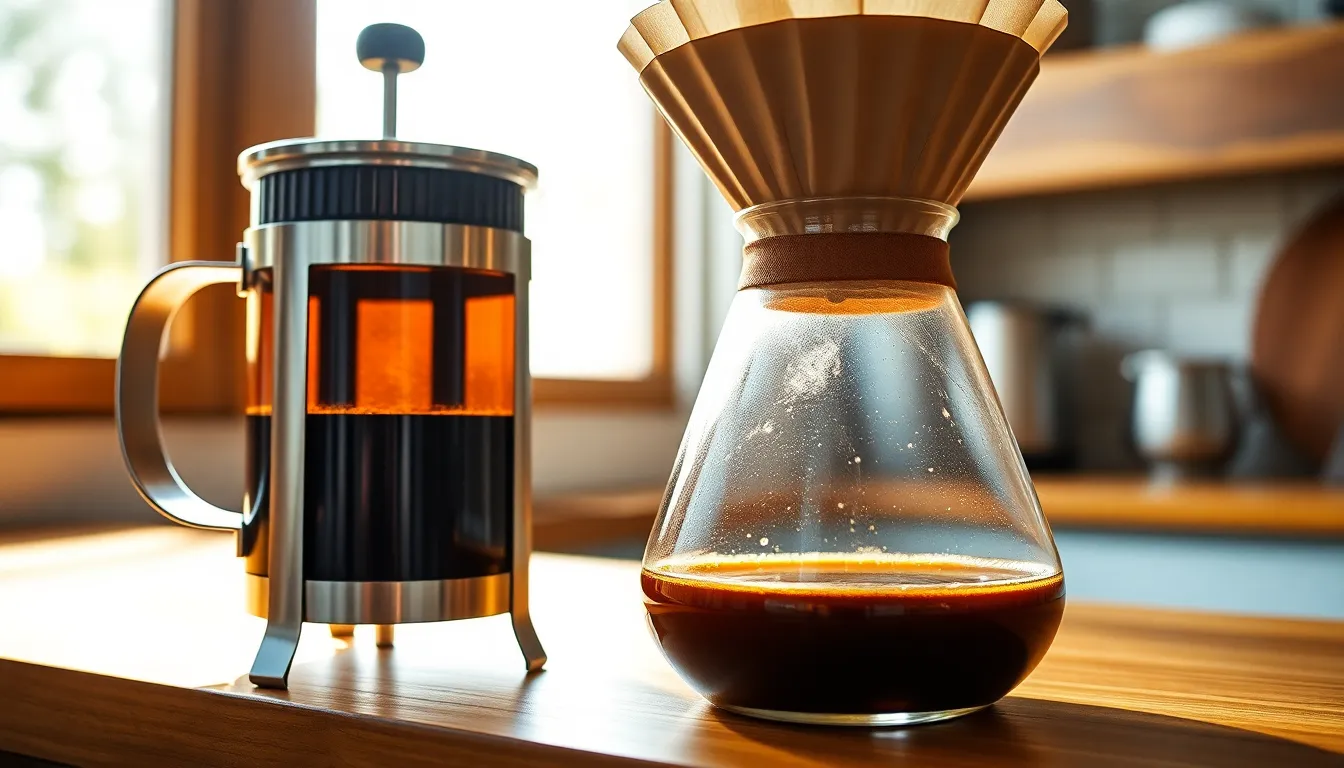
Choosing between a French press and Chemex depends on your coffee preferences, lifestyle, and brewing priorities. Each method offers distinct advantages that appeal to different types of coffee drinkers.
Best for Everyday Use
French Press delivers a straightforward, durable, and flavorful coffee experience ideal for daily brewing. It requires coarse grounds and produces a rich, full-bodied cup through a simple immersion process. Metal or stainless steel models offer exceptional durability, making them perfect for busy households. The French press shines with its versatility—you can brew tea or even cold brew with the same device. Cleanup involves disposing of grounds and a quick rinse, though some sediment typically remains in your cup.
Chemex serves as an excellent everyday option for those who value clean, bright flavors and often brew for multiple people. Its pour-over method with specialized thick filters removes oils and sediment, creating a smooth, crisp cup that highlights subtle flavor notes. The elegant glass carafe makes a statement on any countertop but requires careful handling due to its fragility. Though cleanup includes disposing of a paper filter, many users appreciate the cleaner cup and lack of residual grounds that need scrubbing away.
Best for Coffee Connoisseurs
French Press appeals to coffee enthusiasts who prioritize robustness, aroma, and natural oils in their brew. Without paper filters absorbing essential compounds, this method preserves more flavor depth and complexity. The resulting coffee features a heavy body with pronounced mouthfeel—characteristics that highlight the rich notes in dark roasts and coffees from Indonesia or Colombia. Many connoisseurs appreciate how the French press accentuates chocolate and nutty flavor profiles while delivering an intensely aromatic experience.
Chemex attracts coffee aficionados seeking clarity, brightness, and exceptional cleanliness in their cup. Its proprietary thick filters effectively remove oils and sediment, creating a light, vibrant brew that showcases the coffee’s inherent qualities. This brewing method excels at highlighting the fruity, floral notes in light to medium roasted beans, particularly those from Ethiopia or Kenya. Coffee professionals often choose Chemex when evaluating specialty coffees because it reveals subtle flavor nuances and acidity without the interference of oils or sediment.
| Feature | French Press | Chemex |
|---|---|---|
| Brew Method | Immersion | Pour-over |
| Grind Size | Coarse | Medium-coarse |
| Coffee Taste | Rich, full-bodied, oily | Bright, clean, clear |
| Sediment Presence | Some sediment, possible grounds | Minimal sediment, very clean |
| Capacity | 2-4 cups typically | Larger, good for groups |
| Durability | More durable (stainless steel options) | Fragile (glass) |
| Ease of Use | Simple | Moderate (requires filter prep) |
| Cleanup | Easy | More involved (filter disposal) |
| Versatility | Superior (works for tea, cold brew) | Less versatile |
Choose a French Press if you value robust flavors with natural oils, appreciate durability, and prefer a simple, versatile brewing method that works well for various beverages beyond coffee.
Choose a Chemex if you enjoy bright, clean flavors with minimal sediment, frequently brew for guests, and appreciate the clarity that allows subtle flavor notes to shine through in specialty coffees.
Conclusion
Both French Press and Chemex offer distinctive paths to an exceptional cup of coffee. Your choice eventually depends on your flavor preferences and brewing style.
If you crave bold robust flavors with full body and don’t mind some sediment the French Press delivers with minimal investment and straightforward technique. It’s perfect for those dark roasts you love.
The Chemex shines when you want to experience the bright nuanced notes in specialty coffee without oils or sediment. While requiring more attention and investment it rewards you with an elegant brewing experience and clean cup.
Whichever method you choose you’re embarking on a journey to better coffee beyond ordinary drip machines. Your perfect brew awaits!
Frequently Asked Questions
What’s the main difference between French Press and Chemex coffee?
The main difference lies in extraction method and flavor profile. French Press uses immersion brewing with a metal filter, producing a full-bodied, rich coffee with essential oils intact. Chemex employs a pour-over method with thick paper filters, creating a cleaner, brighter cup without sediment. French Press delivers bold, robust flavors while Chemex highlights subtle, complex notes.
Which brewing method is better for beginners?
The French Press is generally more beginner-friendly. It has fewer variables to control, requires less precision with pouring technique, and is more forgiving of minor mistakes in brewing parameters. Its straightforward plunge mechanism and minimal required equipment make it an excellent entry point for those new to specialty coffee brewing.
How much do French Press and Chemex brewers typically cost?
French Press brewers are more budget-friendly, typically ranging from $20 to $40 depending on size and materials. Chemex brewers start around $45 and can exceed $60 for larger models. The Chemex also requires ongoing purchase of specialized filters, while the French Press has no additional consumable costs.
Which brewing method requires more cleaning?
The French Press requires more cleaning effort. You must disassemble the plunger mechanism and manually remove used grounds from the carafe. The Chemex is easier to clean – simply discard the paper filter with grounds and rinse the glass carafe. However, the Chemex’s narrow neck can sometimes make thorough cleaning more challenging.
What type of coffee works best in each brewer?
French Press excels with dark roasts and coffees with chocolate, nutty, or earthy profiles (like Indonesian or Colombian varieties). The Chemex shines with light to medium roasts that have bright, fruity, or floral characteristics (such as Ethiopian or Kenyan coffees). The brewing method significantly impacts how flavor notes are expressed.
How long does it take to brew coffee with each method?
Both methods require approximately 4-5 minutes of total brewing time. However, the French Press demands less active attention – you simply steep and then plunge. The Chemex requires more hands-on involvement with continuous, controlled pouring throughout the brewing process, demanding more focused attention from the brewer.
Is grind size important for these brewing methods?
Grind size is crucial for both methods. French Press requires a coarse grind to prevent over-extraction and sediment passing through the metal filter. Chemex works best with a medium-coarse grind to balance proper extraction with appropriate flow rate. Consistent grind size is essential for even extraction and balanced flavor with either method.
Which method produces a stronger cup of coffee?
The French Press typically produces a stronger-tasting cup with more body and perceived strength due to its higher oil content and dissolved solids. While both methods can brew coffee with similar caffeine content (determined primarily by coffee-to-water ratio), the French Press’s full-bodied profile often creates an impression of greater strength.

